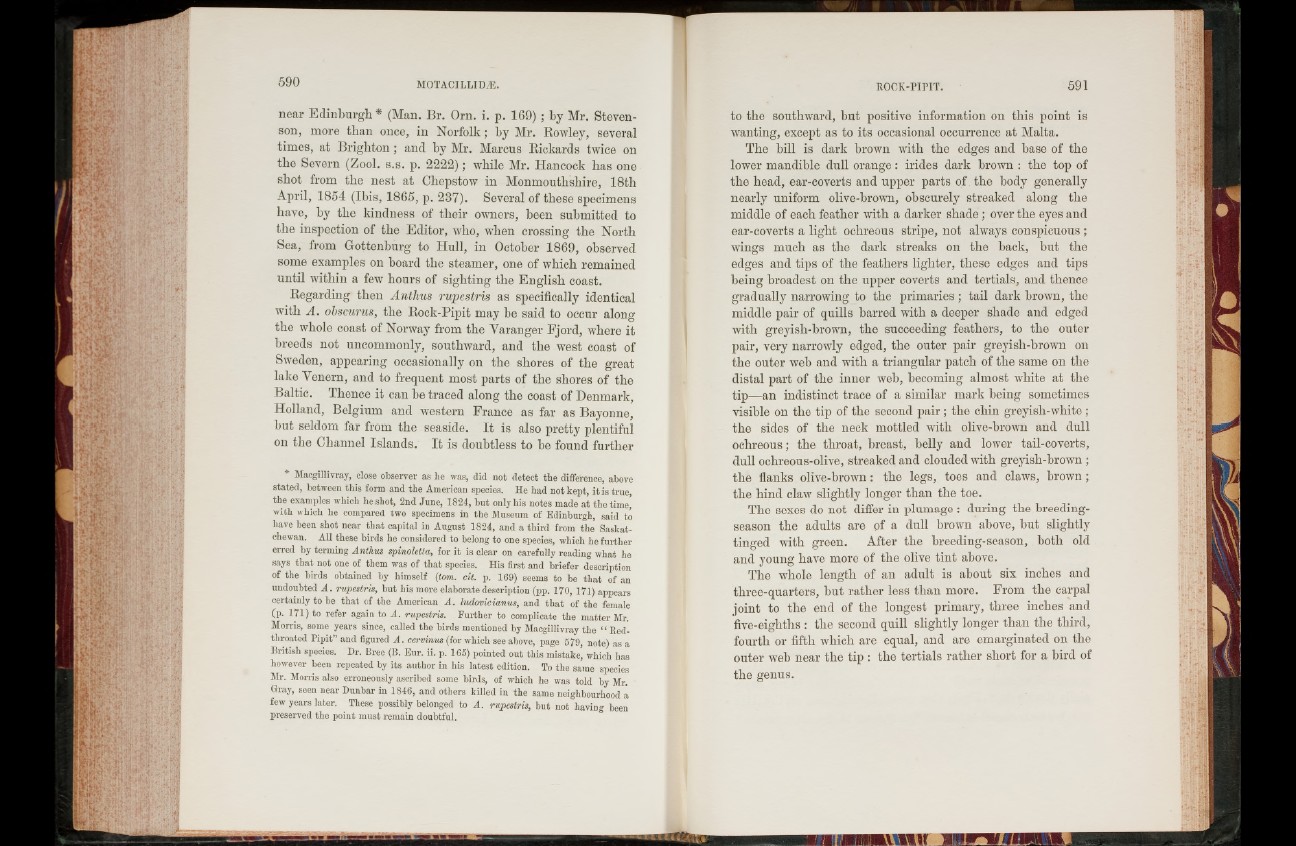
near Edinburgh * (Man. Br. Orn. i. p. 169) ; by Mr. Stevenson,
more than once, in Norfolk; by Mr. Rowley, several
times, at Brighton ; and by Mr. Marcus Rickards twice on
the Severn (Zool. s.s. p. 2222); while Mr. Hancock has one
shot from the nest at Chepstow in Monmouthshire, 18tli
April, 1854 (Ibis, 1865, p. 237). Several of these specimens
have, by the kindness of their owners, been submitted to
the inspection of the Editor, who, when crossing the North
Sea, from Gottenburg to Hull, in October 1869, observed
some examples on board the steamer, one of which remained
until within a few hours of sighting the English coast.
Regarding then Anthus rupestris as specifically identical
with A. obscurus, the Rock-Pipit may be said to occur along
the whole coast of Norway from the Yaranger Fjord, where it
breeds not uncommonly, southward, and the west coast of
Sweden, appearing occasionally on the shores of the great
lake Venern, and to frequent most parts of the shores of the
Baltic. Thence it can be traced along the coast of Denmark,
Holland, Belgium and western France as far as Bayonne,
but seldom far from the seaside. I t is also pretty plentiful
on the Channel Islands. I t is doubtless to be found further
* Macgillivray, close observer as he was, did not detect the difference, above
stated, between this form and the American species. He had not kept, it is true,
the examples which he shot, 2nd June, 1824, but only his notes made at the time,
with which he compared two specimens in the Museum of Edinburgh, said to
have been shot near th a t capital in August 1824, and a third from the Saskatchewan.
All these birds he considered to belong to one species, which he further
erred by terming Anthus spinoletta, for it is clear on carefully reading what he
says that not one of them was of that species. His first and briefer description
of the birds obtained by himself (tom. cit. p. 169) seems to be that of an
undoubted A . rupestris, but his more elaborate description (pp. 170, 171) appears
certainly to be that of the American A . ludovicianus, and th a t of the female
(p. 171) to refer again to A. rupestris. Further to complicate the matter Mr.
Morris, some years since, called the birds mentioned by Macgillivray the “ Ked-
throated Pipit” and figured A. cervinm (for which see above, page 579, note) as a
British species. Dr. Bree (B. Eur. ii. p. 165) pointed out this mistake, which has
however been repeated by its author in his latest edition. To the same species
Mr. Morris also erroneously ascribed some birds, of which he was told by Mr.
Gray, seen near Dunbar in 1846, and others killed in the same neighbourhood a
few years later. These possibly belonged to A. rupestris, but not having been
preserved the point must remain doubtful.
to tlie southward, but positive information on this point is
wanting, except as to its occasional occurrence at Malta.
The hill is dark brown with the edges and base of the
lower mandible dull orange: irides dark brown : the top of
the head, ear-coverts and upper parts of the body generally
nearly uniform olive-brown, obscurely streaked along the
middle of each feather with a darker shade; over the eyes and
ear-coverts a light oclireous stripe, not always conspicuous;
wings much as the dark streaks on the back, but the
edges and tips of the feathers lighter, these edges and tips
being broadest 011 the upper coverts and tertials, and thence
gradually narrowing to the primaries ; tail dark brown, the
middle pair of quills barred with a deeper shade and edged
with greyish-brown, the succeeding feathers, to the outer
pair, very narrowly edged, the outer pair greyish-brown on
the outer web and with a triangular patch of the same on the
distal part of the inner web, becoming almost white at the
tip—an indistinct trace of a similar mark being sometimes
visible on the tip of the second p a ir; the chin greyish-white;
the sides of the neck mottled with olive-brown and dull
ochreous; the throat, breast, belly and lower tail-coverts,
dull ochreous-olive, streaked and clouded with greyish-brown ;
the flanks olive-brown: the legs, toes and claws, brown;
the hind claw slightly longer than the toe.
The sexes do not differ in plumage : during the breeding-
season the adults are of a dull brown above, but slightly
tinged with green. After the breeding-season, both old
and young have more of the olive tint above.
The whole length of an adult is about six inches and
three-quarters, but rather less than more. From the carpal
joint to the end of the longest primary, three inches and
five-eighths : the second quill slightly longer than the third,
fourth or fifth which are equal, and are emarginated on the
outer web near the tip : the tertials rather short for a bird of
the genus.